By Leen Randell
Updated: Jul 08, 2024
10 Best Herbal Decoctions For Sore Eyes
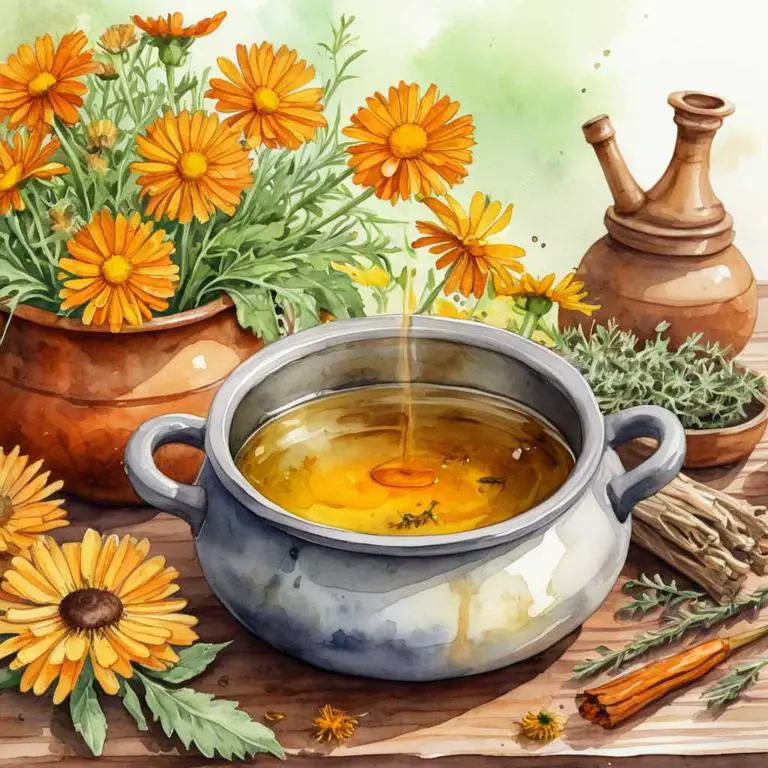
Herbal decoctions for sore eyes are a natural remedy made by steeping herbs in hot water to create a soothing liquid extract.
This concoction helps alleviate sore, itchy, and red eyes by reducing inflammation and promoting healing. Herbs such as chamomile, calendula, and eyebright have anti-inflammatory properties that calm irritated eyes and reduce discomfort.
For example, drinking a warm chamomile decoction can ease dry, tired eyes after a long day of screen time, allowing individuals to enjoy their favorite activities without distraction.
The following article describes in detail the most important decoctions for sore eyes, including medicinal properties, parts of herbs to use, and recipes for preparations.
- 1. Euphrasia officinalis
- 2. Calendula officinalis
- 3. Hypericum perforatum
- 4. Achillea millefolium
- 5. Echinacea angustifolia
- 6. Matricaria chamomilla
- 7. Taraxacum officinale
- 8. Equisetum arvense
- 9. Plantago major
- 10. Foeniculum vulgare
- What is the best combination of herbal decoctions to use for sore eyes?
- What ailments similar to sore eyes are treated with herbal decoctions?
1. Euphrasia officinalis
Eyebright decoctions helps with sore eyes because they possess potent anti-inflammatory and antibacterial properties.
The herbs' bioactive compounds, such as flavonoids and phenolic acids, work to reduce swelling and redness in the eyes, alleviating discomfort and dryness. Additionally, eyebright's antimicrobial qualities help combat underlying infections that can cause eye irritation.
By soothing and calming the eyes, eyebright decoctions provide natural relief from sore, itchy, or irritated eyes, promoting healthy vision and overall ocular well-being.
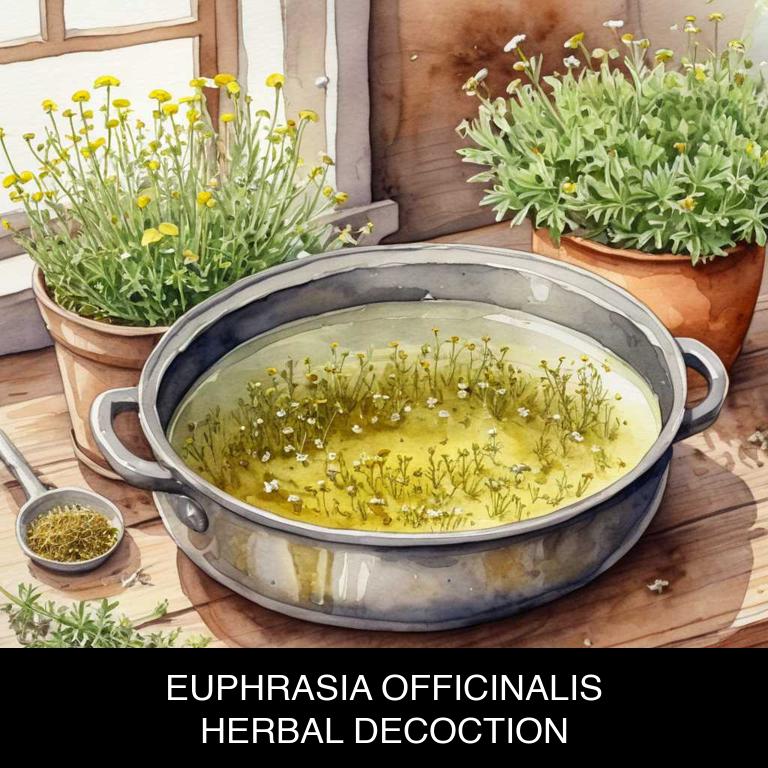
Medicinal Constituents
The list below shows the primary medicinal constituents in Euphrasia officinalis decoctions that help with sore eyes.
- Iridoid glycosides: These compounds help reduce inflammation and soothe irritated tissues in the eyes, providing relief from soreness and discomfort.
- Leucoside a: This iridoid glycoside has anti-inflammatory properties that help calm and protect the eyes from further irritation, promoting healing and reducing the risk of complications.
- Triterpenoid saponins: These compounds exhibit antimicrobial properties, helping to eliminate underlying infections that may be contributing to sore eyes, and promoting a healthy environment for the eyes to recover.
Parts Used
The list below shows the primary parts of eyebright used to make decoctions for sore eyes.
- Leaves: Rich in bioactive compounds, they help soothe and reduce inflammation in the eyes.
- Flowers: Containing flavonoids and other antioxidants, they aid in calming and protecting the eyes.
- Roots: Possessing anti-inflammatory properties, they help alleviate pain and swelling associated with sore eyes.
Quick Recipe
The following recipe gives a procedure to make a basic eyebright for sore eyes.
- Harvest fresh leaves and flowers of the plant in the early morning or late afternoon when the dew is still present.
- Clean the harvested plant material by rinsing it gently with cold water to remove any dirt or debris.
- Chop the cleaned plant material into small pieces using a sharp knife to increase its surface area.
- Combine the chopped plant material with 1 part of it to 10 parts of water in a saucepan and bring to a boil.
- Simmer the mixture for 10 to 15 minutes and then let it steep for an additional 10 to 15 minutes.
2. Calendula officinalis
Pot marigold decoctions helps with sore eyes because of its potent anti-inflammatory and antimicrobial properties.
The decoction's active compounds, including flavonoids and terpenes, work to reduce inflammation and alleviate redness, itching, and burning sensations associated with sore eyes. Additionally, the decoction's antibacterial and antifungal properties help to combat underlying infections that may be contributing to eye irritation.
By soothing and calming the eyes, pot marigold decoctions provide natural relief from sore and irritated eyes.

Medicinal Constituents
The list below shows the primary medicinal constituents in Calendula officinalis decoctions that help with sore eyes.
- Triterpenoid saponins: These saponins have anti-inflammatory properties, which help reduce swelling and soothe sore, irritated eyes.
- Phenolic acids: These flavonoids exhibit potent antioxidant and anti-inflammatory activities, which help alleviate eye redness and irritation.
- Nordammarcone and other triterpenoids: These compounds have been shown to possess antimicrobial properties, which can help prevent infections and promote healing in sore, compromised eye tissues.
Parts Used
The list below shows the primary parts of pot marigold used to make decoctions for sore eyes.
- Flowers: They are used for making decoctions for sore eyes because of their anti-inflammatory and antiseptic properties.
- Leaves: They are used for making decoctions for sore eyes because of their ability to soothe and calm the irritated eyes.
- Roots: They are used for making decoctions for sore eyes because of their rich content of saponins, which have anti-inflammatory effects.
Quick Recipe
The following recipe gives a procedure to make a basic pot marigold for sore eyes.
- Harvest fresh calendula officinalis flowers when they are in full bloom and the petals are completely open.
- Rinse the calendula officinalis flowers with cold water to remove any dirt or debris.
- Combine one tablespoon of dried calendula officinalis flowers with one cup of boiling water to make a decoction.
- Steep the calendula officinalis flowers in the boiling water for 5 to 10 minutes to release their properties.
- Strain the decoction through a cheesecloth or a fine-mesh sieve to remove the calendula officinalis flowers.
3. Hypericum perforatum
St John's Wort decoctions help with sore eyes because of their anti-inflammatory properties, which reduce redness and swelling.
The decoction's flavonoids and glycosides work together to soothe and calm the eyes, providing relief from discomfort and fatigue. Additionally, St John's Wort has natural antibacterial and antiviral properties that help combat infections, such as conjunctivitis, and promote healthy eye functioning.
This natural remedy is a gentle and effective way to alleviate sore eyes without relying on harsh chemicals or medications.
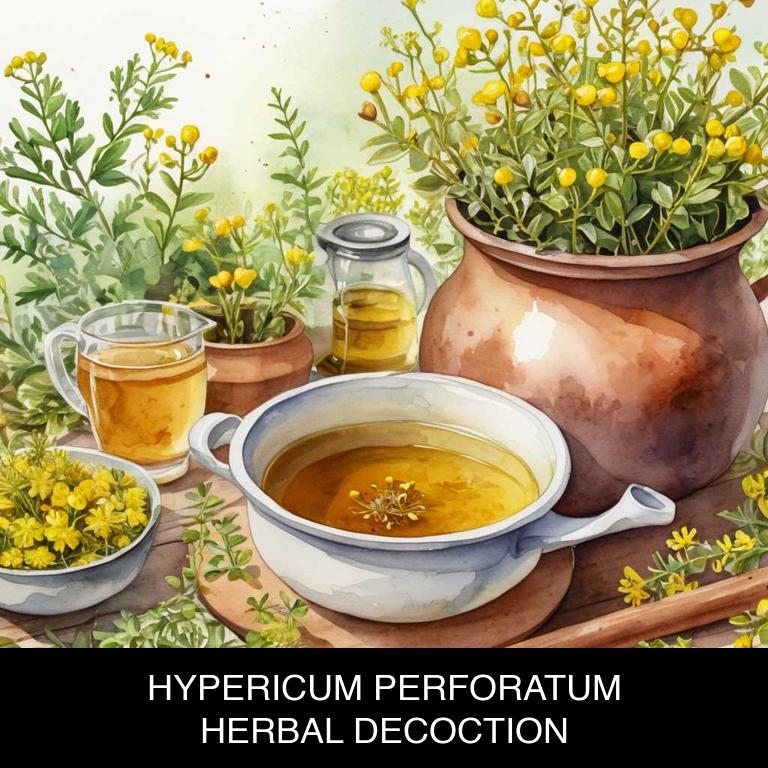
Medicinal Constituents
The list below shows the primary medicinal constituents in Hypericum perforatum decoctions that help with sore eyes.
- Hyperforin: This phenolic compound has anti-inflammatory properties, which help reduce the swelling and discomfort associated with sore eyes.
- Quercetin: As a flavonoid and phenolic compound, quercetin exhibits potent antioxidant and anti-inflammatory effects, which aid in soothing and calming sore eyes.
- Hyperoside: This flavonoid glycoside possesses anti-inflammatory and antioxidant properties, which help alleviate redness, swelling, and irritation in sore eyes.
Parts Used
The list below shows the primary parts of st john's wort used to make decoctions for sore eyes.
- Leaves: Rich in flavonoids and tannins, which have anti-inflammatory properties that can help soothe and calm sore eyes.
- Flowers: High in hypericin and hyperforin, which have antiseptic and anti-inflammatory properties that can help reduce inflammation and promote healing in sore eyes.
- Stems: Contain a combination of flavonoids and phenolic acids that can help reduce inflammation and promote the healing of sore eyes.
Quick Recipe
The following recipe gives a procedure to make a basic st john's wort for sore eyes.
- Gather 1 teaspoon of dried hypericum perforatum flowers and 2 cups of boiling water for preparation.
- Steep the dried flowers in the boiling water for 5 to 10 minutes to release active compounds.
- Strain the mixture through a cheesecloth or fine-mesh sieve into a bowl to remove solids.
- Discard the solids and store the decoction in the refrigerator for up to 2 days or freeze for later use.
- Consume 1 to 2 tablespoons of the decoction up to 3 times a day as directed by a healthcare professional.
4. Achillea millefolium
Yarrow decoctions helps with sore eyes because its unique blend of flavonoids, terpenes, and saponins provides anti-inflammatory and antibacterial properties that soothe irritated tissues.
The decoction's ability to reduce swelling and ease redness makes it an effective natural remedy for alleviating the discomfort caused by conjunctivitis, dry eyes, or minor injuries.
Additionally, yarrow's antioxidant properties help protect the delicate eye tissues from further damage, promoting healthy vision and optimal eye function.
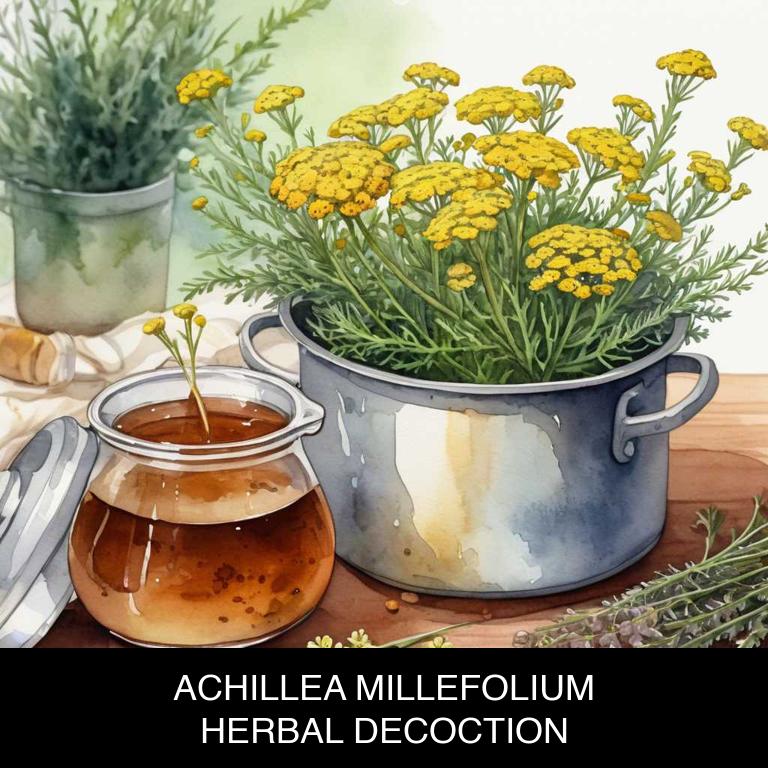
Medicinal Constituents
The list below shows the primary medicinal constituents in Achillea millefolium decoctions that help with sore eyes.
- Fernanduline: Fernanduline, a sesquiterpene lactone, has anti-inflammatory properties that help reduce swelling and alleviate pain in sore eyes.
- Nepalensine: Nepalensine, a sesquiterpene lactone, has antioxidant and anti-inflammatory effects that help protect the eyes from oxidative damage and reduce inflammation associated with sore eyes.
- Apigenin: Apigenin, a flavonoid, has anti-inflammatory and antioxidant properties that help reduce inflammation, alleviate pain, and protect the eyes from oxidative damage, making it effective in soothing sore eyes.
Parts Used
The list below shows the primary parts of yarrow used to make decoctions for sore eyes.
- Leaves: The leaves of Achillea millefolium are used to make decoctions for sore eyes because they contain anti-inflammatory compounds that help reduce swelling and soothe irritated tissues.
- Flowers: The flowers of Achillea millefolium are used to make decoctions for sore eyes because they possess antimicrobial properties that help combat infections and promote healing.
- Stems: The stems of Achillea millefolium are used to make decoctions for sore eyes because they contain compounds that help reduce inflammation and promote relaxation.
Quick Recipe
The following recipe gives a procedure to make a basic yarrow for sore eyes.
- Harvest 1/4 cup of fresh achillea millefolium leaves and flowers in the late morning or early afternoon.
- Dry the harvested leaves and flowers at 150 degrees fahrenheit for 2 hours to reduce moisture content.
- Combine 1 teaspoon of dried achillea millefolium with 1 quart of boiling water to create a decoction.
- Steep the mixture for 5-7 minutes to allow the herbs to release their active compounds and flavors.
- Strain the decoction through a cheesecloth or fine-mesh sieve into a clean glass container to remove solids.
5. Echinacea angustifolia
Kansas coneflower decoctions helps with sore eyes because of its natural anti-inflammatory properties, which soothe and calm irritated eye tissue.
The decoction's flavonoids and terpenes work to reduce swelling and redness, while its antihistamine effects help alleviate itchiness and discomfort. Additionally, the decoction's antimicrobial properties may help combat underlying infections that contribute to sore eyes.
Overall, herbal Kansas coneflower decoctions provide a gentle yet effective remedy for soothing tired, irritated eyes.
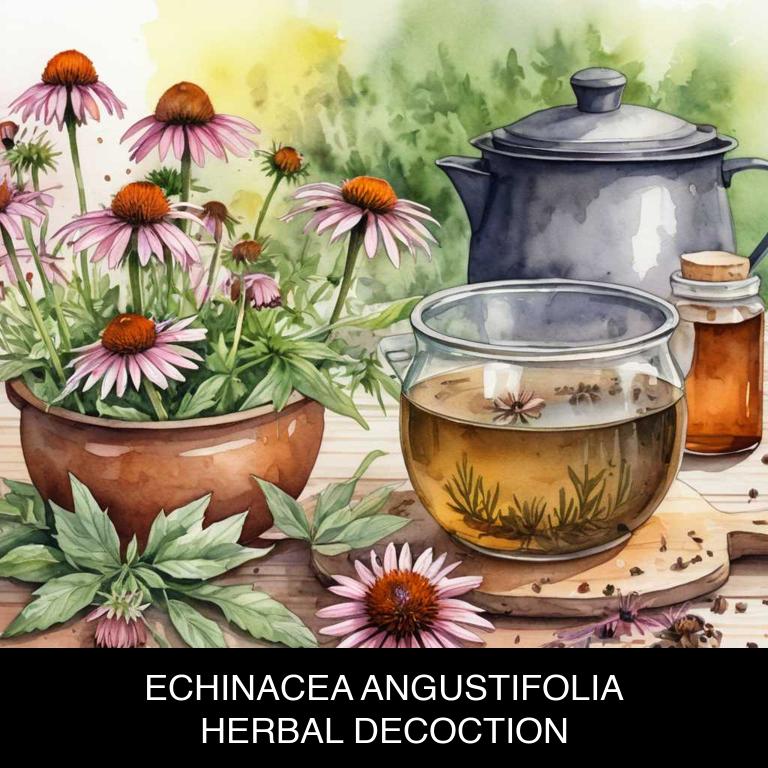
Medicinal Constituents
The list below shows the primary medicinal constituents in Echinacea angustifolia decoctions that help with sore eyes.
- Iridoid glycosides: These compounds help reduce inflammation and soothe sore eyes by inhibiting the production of pro-inflammatory enzymes.
- Phenylethanoid glycosides: These compounds possess anti-inflammatory and antioxidant properties, which help alleviate soreness and discomfort associated with eye inflammation.
- Cichoric acid: This compound has potent anti-inflammatory and antioxidant effects, which help reduce redness, swelling, and irritation in the eyes, thereby providing relief from sore eyes.
Parts Used
The list below shows the primary parts of kansas coneflower used to make decoctions for sore eyes.
- Roots: They are the most commonly used part due to their high concentration of bioactive compounds that help soothe and reduce inflammation in the eyes.
- Leaves: Leaves are used for their antiseptic and anti-inflammatory properties, which aid in reducing redness and swelling associated with sore eyes.
- Buds: Buds are also utilized for their medicinal properties, which help in reducing eye irritation and inflammation, although their use might be less widespread compared to roots and leaves.
Quick Recipe
The following recipe gives a procedure to make a basic kansas coneflower for sore eyes.
- Harvest 10-20 grams of dried echinacea angustifolia root and rhizome from a trusted source.
- Weigh the dried root and rhizome and add to 1 liter of boiling water.
- Steep the mixture for 10-15 minutes in a covered saucepan on low heat.
- Strain the decoction through a cheesecloth or a fine-mesh sieve into a clean container.
- Store the cooled decoction in a dark glass bottle in the refrigerator for up to 3 days.
6. Matricaria chamomilla
Chamomile decoctions helps with sore eyes because of its anti-inflammatory and soothing properties.
The apigenin present in chamomile binds to alpha receptors in the eye, reducing inflammation and promoting relaxation. Additionally, the calming effects of chamomile help to reduce redness and itchiness, providing relief from dry, irritated, or fatigued eyes.
By gently bathing the eyes with a warm chamomile infusion, individuals can find instant comfort and respite from discomfort, making it an effective natural remedy for soothing sore eyes.
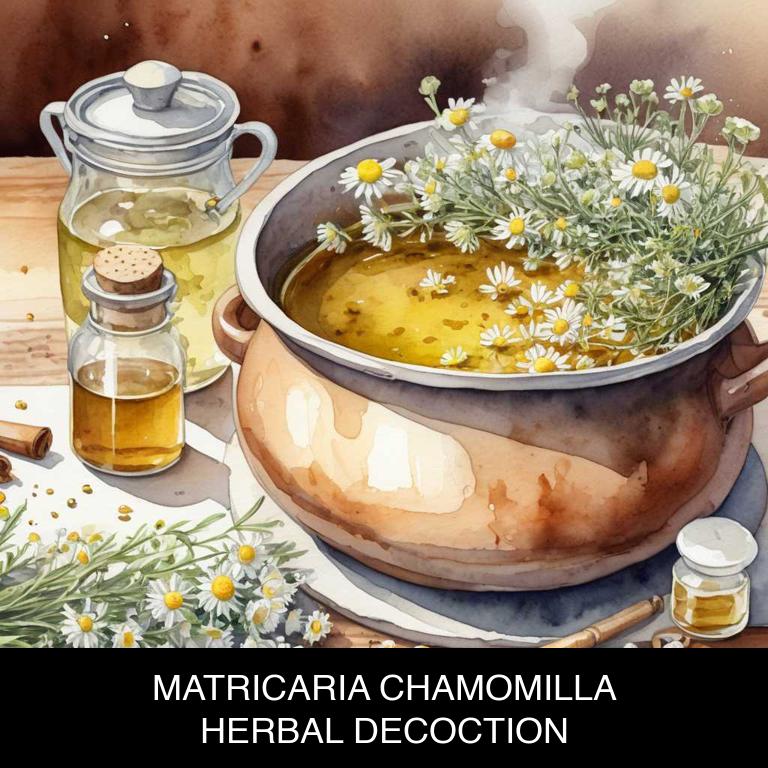
Medicinal Constituents
The list below shows the primary medicinal constituents in Matricaria chamomilla decoctions that help with sore eyes.
- Apigenin: This flavonoid acts as a potent anti-inflammatory agent, helping to reduce inflammation and soothe sore eyes.
- Luteolin: This flavonoid possesses antioxidant and anti-inflammatory properties, which help to protect the eyes from oxidative stress and inflammation, thereby reducing discomfort and pain.
- Bisabolol: This sesquiterpene lactone has anti-inflammatory and soothing properties, helping to calm and comfort sore eyes, reducing redness and irritation.
Parts Used
The list below shows the primary parts of chamomile used to make decoctions for sore eyes.
- Flowers: They are rich in anti-inflammatory compounds and antioxidants, making them effective in reducing eye inflammation and promoting healing.
- Leaves: Leaves of Matricaria chamomilla contain flavonoids and other bioactive compounds that have anti-inflammatory and antimicrobial properties, which help to soothe and protect the eyes.
- Seeds: Matricaria chamomilla seeds are a good source of essential oils and fatty acids, which can help to reduce eye inflammation and promote healing when used in decoctions.
Quick Recipe
The following recipe gives a procedure to make a basic chamomile for sore eyes.
- Gather 1 teaspoon of dried matricaria chamomilla flowers and 1 cup of boiling water.
- Steep the dried flowers in the boiling water for 5 to 7 minutes.
- Strain the mixture through a fine-mesh sieve to remove the solids.
- Discard the solids and store the decoction in the refrigerator for up to 3 days.
- Warm the decoction before consumption by gently heating it in the microwave or on the stovetop.
7. Taraxacum officinale
Dandelion decoctions helps with sore eyes because of its anti-inflammatory and antioxidant properties.
The plant's rich content of vitamins A, C, and E, as well as its flavonoids and terpenes, work together to reduce redness, swelling, and irritation in the eyes. Additionally, dandelion's natural antibacterial properties help to combat infection-causing bacteria that can contribute to sore eyes.
When consumed as a decoction, these benefits are absorbed into the bloodstream, providing relief from dry, itchy, or irritated eyes.

Medicinal Constituents
The list below shows the primary medicinal constituents in Taraxacum officinale decoctions that help with sore eyes.
- Flavonoids: These plant compounds, particularly quercetin and kaempferol, have anti-inflammatory properties, which can help reduce eye inflammation and alleviate soreness.
- Phenylethanoids: Phenylethanoids, such as taraxasterol, have been shown to possess anti-inflammatory and antioxidant activities, which can help protect the eyes from damage and promote healing.
- Saponins: Saponins, like taraxasterol, have been found to exhibit anti-inflammatory properties, which may help soothe and calm irritated eyes, reducing soreness and discomfort.
Parts Used
The list below shows the primary parts of dandelion used to make decoctions for sore eyes.
- Flowers: The flowers are used to make decoctions for sore eyes due to their anti-inflammatory properties.
- Leaves: The leaves are used to make decoctions for sore eyes due to their soothing and cooling effects.
- Roots: The roots are used to make decoctions for sore eyes due to their potential to reduce swelling and inflammation.
Quick Recipe
The following recipe gives a procedure to make a basic dandelion for sore eyes.
- Harvest 25-30 fresh leaves and roots of taraxacum officinale in the early morning or evening when the plant is at its highest potency level.
- Wash the harvested taraxacum officinale leaves and roots thoroughly with cold water to remove any dirt or debris.
- Combine the washed taraxacum officinale leaves and roots with 1 liter of water in a saucepan and bring to a boil.
- Reduce the heat and let the taraxacum officinale decoction simmer for 5-10 minutes to release its bioactive compounds.
- Strain the taraxacum officinale decoction through a cheesecloth or a fine mesh into a clean container and discard the solids.
8. Equisetum arvense
Field horsetail decoctions helps with sore eyes because it contains antioxidants and anti-inflammatory compounds that soothe and calm irritated eyes.
The plant's high silica content also helps to strengthen and nourish the delicate tissues of the eye, reducing redness and swelling.
Additionally, field horsetail has antimicrobial properties that can help combat infections and prevent further irritation, providing long-lasting relief from sore and tired eyes.
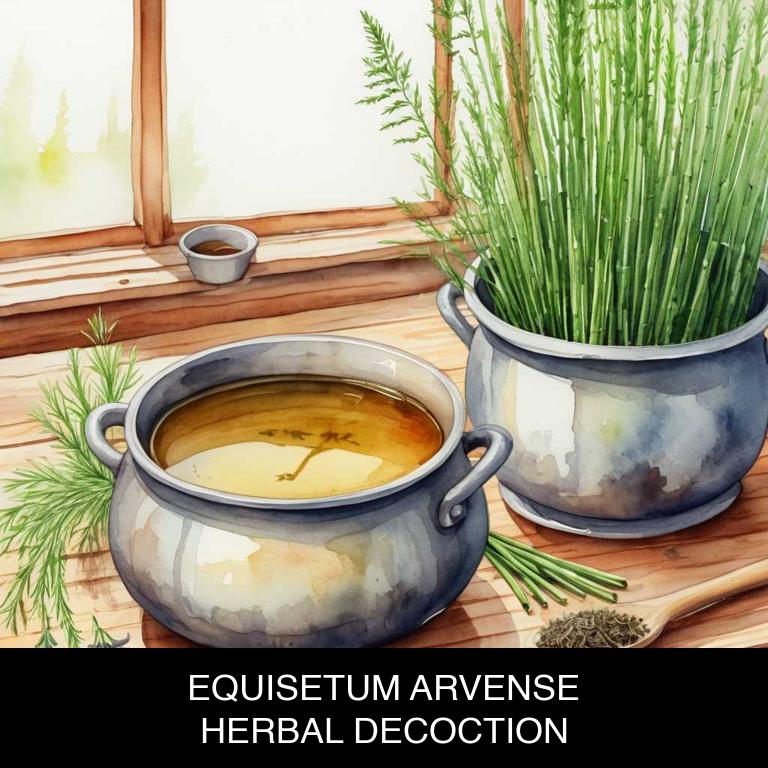
Medicinal Constituents
The list below shows the primary medicinal constituents in Equisetum arvense decoctions that help with sore eyes.
- Silica: Helps to reduce inflammation and promote healing in the eyes, soothing soreness and discomfort.
- Tannins: Exhibits anti-inflammatory and antioxidant properties, which may help to alleviate redness and swelling associated with sore eyes.
- Flavonoids: Possesses antioxidant and anti-inflammatory properties, which can help to protect the eyes from oxidative stress and reduce inflammation, thereby alleviating soreness.
Parts Used
The list below shows the primary parts of field horsetail used to make decoctions for sore eyes.
- Roots: They contain anti-inflammatory compounds that help reduce swelling and soothe sore eyes.
- Leaves: They have antibacterial and antiviral properties that help combat infections and promote healing in the eyes.
- Stems: They contain soothing and anti-inflammatory compounds that help calm irritated eyes and reduce discomfort.
Quick Recipe
The following recipe gives a procedure to make a basic field horsetail for sore eyes.
- Gather equisetum arvense rhizomes and roots from trusted herbal sources.
- Clean and wash the equisetum arvense rhizomes and roots with cold water.
- Chop the equisetum arvense rhizomes and roots into small pieces approximately 1 gram.
- Steep 1 gram of chopped equisetum arvense rhizomes and roots in 250 milliliters of boiling water for 10 minutes.
- Strain the decoction through a cheesecloth or a fine-mesh sieve into a clean container.
9. Plantago major
Plantain decoctions helps with sore eyes because of its anti-inflammatory and antioxidant properties.
The plantain plant contains compounds that help reduce swelling and soothe irritation in the eyes. When made into a decoction, these compounds are released, providing fast relief from symptoms such as redness, itchiness, and dryness. Additionally, the antibacterial and antifungal properties of plantain help combat infections and promote healing.
As a result, herbal plantain decoctions offer a natural and effective way to alleviate sore eyes and maintain healthy vision.
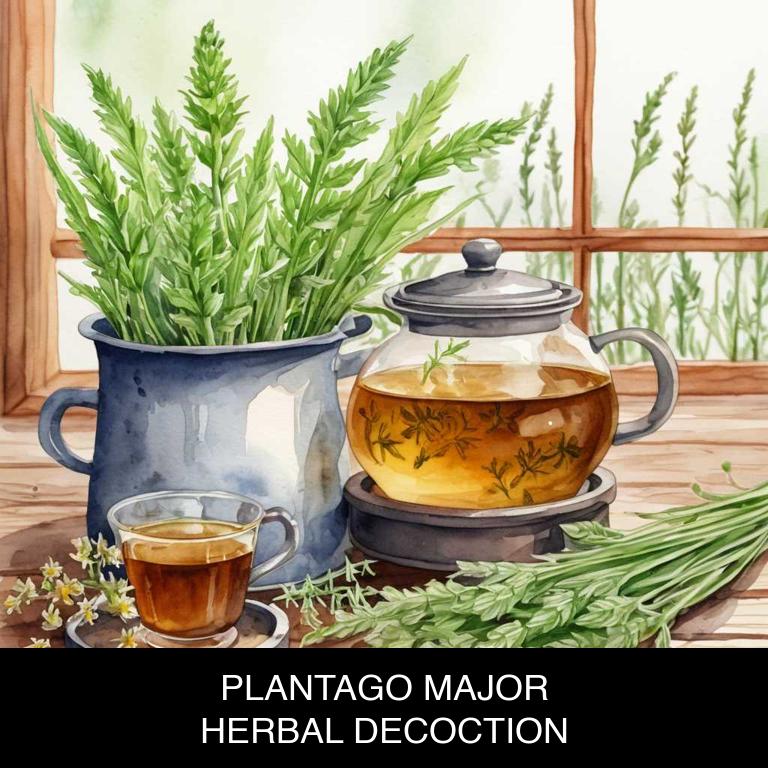
Medicinal Constituents
The list below shows the primary medicinal constituents in Plantago major decoctions that help with sore eyes.
- Phenolic acids: These compounds have anti-inflammatory properties, which help to reduce swelling and redness in the eyes, thereby alleviating sore eye discomfort.
- Flavonoids: Flavonoids, particularly quercetin, have potent antioxidant and anti-inflammatory effects that help to protect the eyes from oxidative stress and inflammation, promoting healing and soothing sore eyes.
- Polysaccharides: These complex carbohydrates have anti-inflammatory and immunomodulatory properties, which help to regulate the immune response and reduce inflammation in the eyes, providing relief from sore eye symptoms.
Parts Used
The list below shows the primary parts of plantain used to make decoctions for sore eyes.
- Leaves: They are used because of their anti-inflammatory and soothing properties, which help to reduce eye inflammation and promote healing.
- Roots: They are used because of their astringent properties, which help to reduce swelling and promote the healing of sore eyes.
- Seeds: They are used because of their expectorant properties, which help to clear out mucus and other debris that may be causing eye irritation.
Quick Recipe
The following recipe gives a procedure to make a basic plantain for sore eyes.
- Gather 1-2 cups of dried plantago major leaves and flowers, clean and free of debris.
- Weigh 20-30 grams of the dried herb and add it to a large saucepan with 2 liters of water.
- Bring the mixture to a boil over medium heat and then reduce the heat to low.
- Simmer the decoction for 10-15 minutes, or until the liquid has reduced slightly and the flavors have infused.
- Strain the decoction through a cheesecloth or fine-mesh sieve into a clean container, discarding the solids.
10. Foeniculum vulgare
Fennel decoctions helps with sore eyes because of its natural anti-inflammatory properties.
The herb contains flavonoids, which have been shown to reduce swelling and ease discomfort in the eyes. When used as an eyewash or eye drops, fennel decoctions can help soothe irritated eyes, relieve itchiness and dryness, and even reduce redness caused by allergies, conjunctivitis, or other irritations.
This natural remedy has been used for centuries to provide quick relief from sore, itchy, and tired eyes.
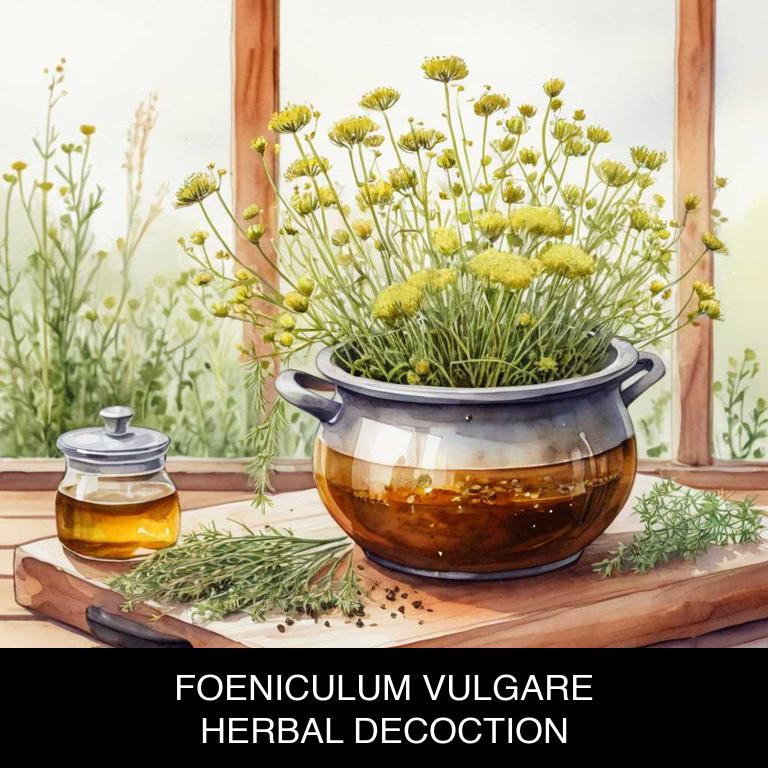
Medicinal Constituents
The list below shows the primary medicinal constituents in Foeniculum vulgare decoctions that help with sore eyes.
- Falcarinol: This sesquiterpene is known for its anti-inflammatory properties, which can help reduce redness and swelling associated with sore eyes.
- Anethol: As a phenolic compound, anethol has been shown to have antimicrobial and anti-inflammatory effects, which can help soothe and protect sore eyes from infection.
- Selinene: This sesquiterpene has been found to possess anti-inflammatory and antioxidant properties, which can help reduce oxidative stress and promote healing in sore eyes.
Parts Used
The list below shows the primary parts of fennel used to make decoctions for sore eyes.
- Leaves: Used to make decoctions for sore eyes due to their anti-inflammatory properties that help soothe and calm irritated eyes.
- Seeds: Used to make decoctions for sore eyes due to their carminative and anti-inflammatory properties that help reduce swelling and discomfort.
- Stems: Used to make decoctions for sore eyes due to their ability to reduce inflammation and promote healing in the eyes.
Quick Recipe
The following recipe gives a procedure to make a basic fennel for sore eyes.
- Harvest fresh foeniculum vulgare roots and clean them thoroughly with cold water.
- Chop 20 grams of the cleaned roots into small pieces and store them in a container.
- Combine the chopped roots with 500 milliliters of water in a saucepan and bring to a boil.
- Reduce the heat to a simmer and let the decoction steep for 10 to 15 minutes.
- Strain the decoction through a cheesecloth or a fine-mesh sieve into a clean container.
What is the best combination of herbal decoctions to use for sore eyes?
The best combination of herbal decoctions that help with sore eyes is a blend of peppermint, chamomile, and calendula.
Peppermint's anti-inflammatory properties soothe the eyes, while chamomile's calming effects reduce redness and irritation. Calendula's antiseptic and antibacterial properties help to prevent infection and promote healing. To use, steep 1 teaspoon of dried peppermint and chamomile in 1 cup of boiling water for 5-7 minutes, then add 1 teaspoon of dried calendula and let steep for another minute.
Strain and apply as a warm compress to the affected eyes.
What ailments similar to sore eyes are treated with herbal decoctions?
Ailments similar to sore eyes that are treated with herbal decoctions are conjunctivitis, blepharitis, and meibomian gland dysfunction.
Herbs such as chamomile, calendula, and eyebright are used in decoctions to soothe and calm irritated eyes. Decoctions can also be used to treat other eye-related conditions like cataracts, glaucoma, and dry eye syndrome.
These herbal remedies help reduce inflammation, promote healing, and improve vision.